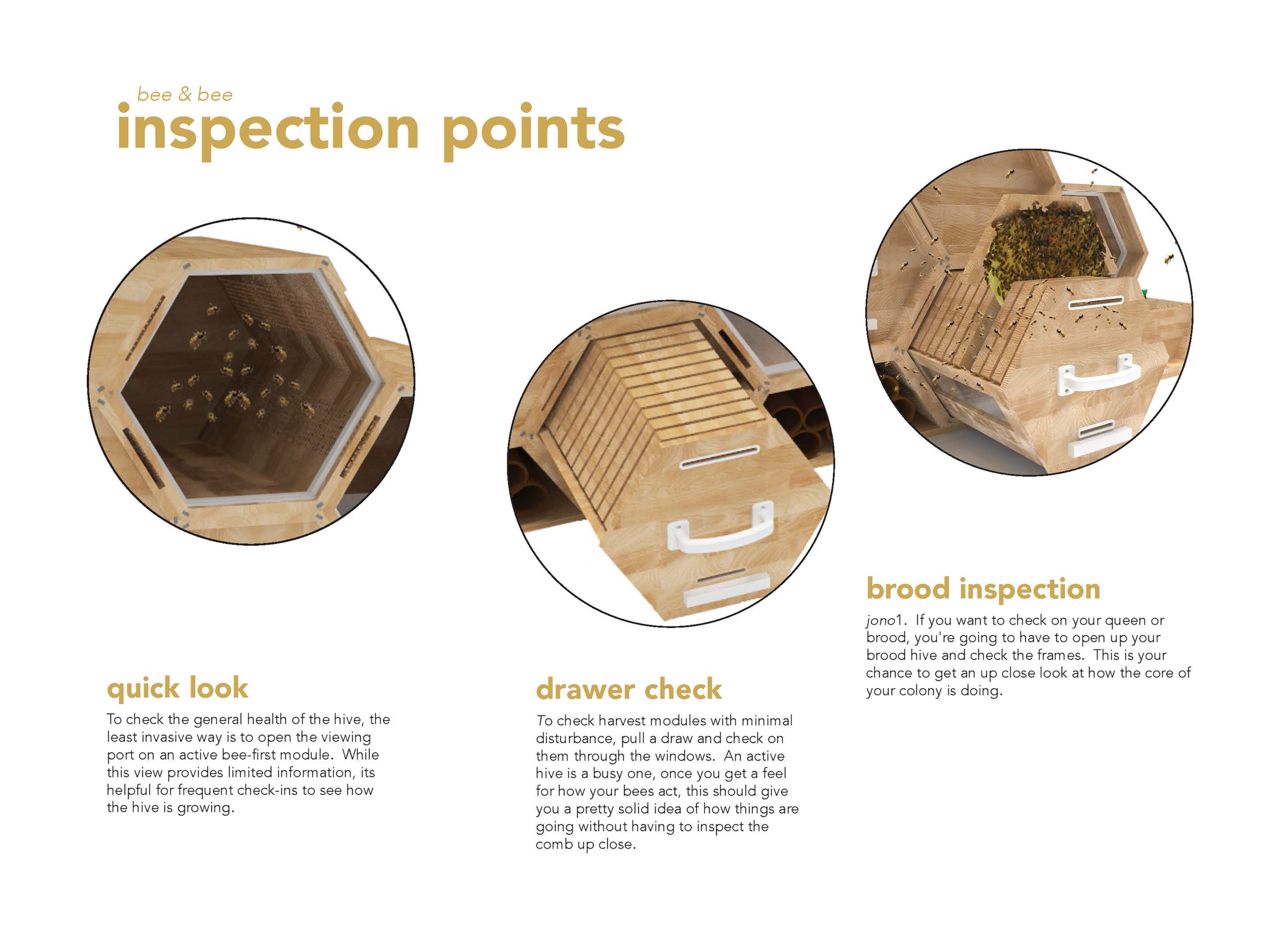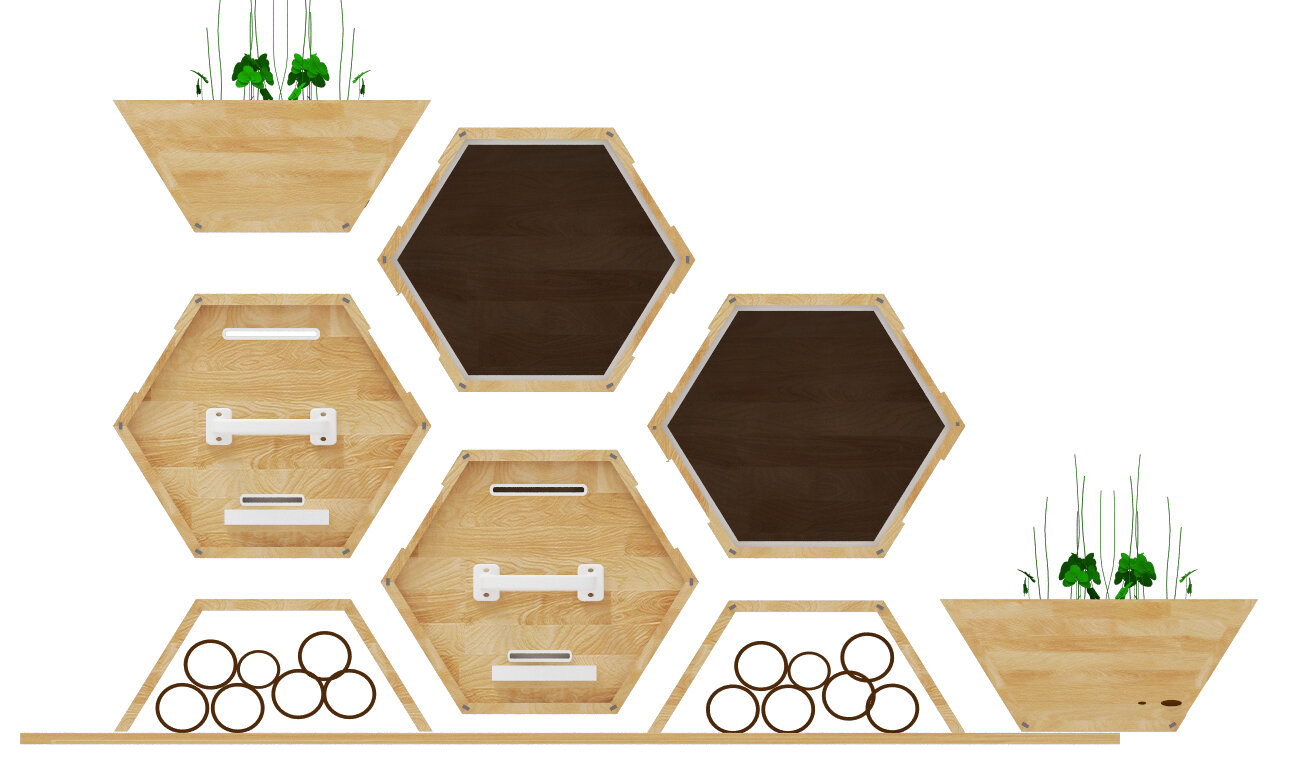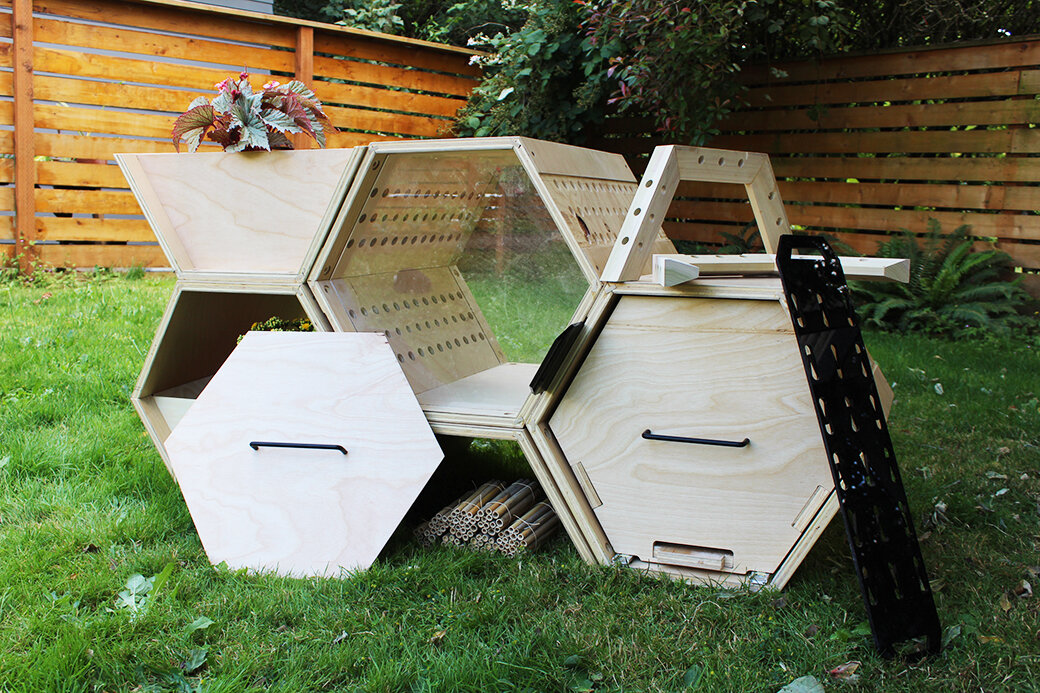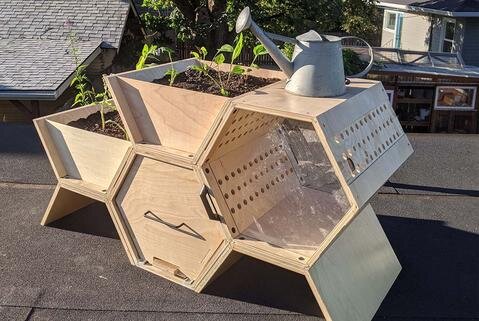
The Bee & Bee
The Bee & Bee is a modular backyard beehive system that I designed during my time at The Pacific Northwest College of Art. Conceived within the graduate design lab or Bee Lab, the goal was to design a hive that balanced the needs of the Pacific Northwest backyard beekeeper with the needs of honey bees, native bees, and the garden environment. The Bee Lab was a collaboration between Pacific Northwest College of Art (PNCA) and Blendily, a skincare kitchen where fresh, locally grown and gathered herbs and flowers are “blended splendidly” with exotic botanicals to create an array of bath & body products.
The Bee Lab team consisted of five design students from PNCA’s Collaborative Design/Design Systems (CD/DS) Master’s program. The CD/DS program brings people from a variety of disciplines together to leverage a diversity of talents and skills. We collaborated on our initial research before splitting up to design and prototype our own hives. These prototypes were then pitched to the client before the team came back together to build and install the chosen hive.
After learning everything we could about both bees and our client, I interviewed both a female backyard beekeeper and a commercial beekeeper to learn about their needs, desires, and struggles.
Based on the combination of our primary and secondary research, we settled on the following design criteria to work towards creating an approach to beekeeping that we called “balance of impact”.
Modularity - An integrated hive serves multiple functions simultaneously, modular elements create ways to customize the hive to the beekeepers specific needs and environment.
Visibility - Making the hive easy to inspect without disturbing the bees means less disruption for the bees and less potential danger and hassle for the beekeeper
Ease of Use - Backyard beekeepers don’t have the skills, muscles or specialized tools that commercial bee keepers do, so making all the parts of the hive light enough to move easily and easy to interact with is important
Production/Harvest - Although the hive should support bee health, it should also provide harvestable quantities of honey, wax, propolis, and pollen.
Garden Integration - All bees depend on a thriving garden with flowers that bloom for as much of the year as possible. The hive system should include features that help the garden and the bees thrive.
Prototyping
When I began designing my hive, I wasn’t thinking about the form that it might take. I began by thinking about the behavior that I was designing for and the interactions that it would necessitate. From my research, I had learned that, above all else, bees are happiest and their colonies most successful when they are completely left alone… or at least when they think they are left alone.
The same can be said for most people, who would generally prefer to not be swarmed by bees regularly. This is why I focused on minimizing contact between bees and beekeepers and created a system with that function at its core. The hive took several forms before I eventually settled on The Bee & Bee which mimicked the existing for of honeycomb to create a modular hive system that balanced the impact on both bees and humans.
The Bee & Bee is a simple garden system and pollinator habitat aimed at seamlessly integrating backyard beekeeping with rooftop gardening. The modular construction allows for the user to expand upon either the beekeeping or gardening functions as they see fit while a combination of different hive modules promotes a balanced approach to harvesting bee products. A unique bee access channel system allows beekeepers to “herd” bees making it possible to have almost no interaction with them. Life happens, to both people and bees, so the Bee & Bee is designed to provide value even if it should be uninhabited for a time. Once the colony is established, baseline maintenance is minimal, only requiring intervention a few times a season.
The Bee & Bee is designed to balance impact on both humans and bees in 3 ways.
Most beekeeping systems require lifting which can be strenuous on the beekeeper, especially when it is full of 50+ pounds of honey. The Bee & Bee keeps the hive within a drawer system that allows the beekeeper to inspect and harvest with minimal lifting.
Interaction between bees and beekeepers is stressful for both parties, especially during harvest. Most beekeeping practices rely on using a smoker to expel bees from the hive which can be traumatic for the colony. The Bee & Bee utilizes a series of channels to herd bees, making it possible to severely limit interaction between the bees and their keeper. The be channels are designed to allow travel between modules so that the hive can grow as it sees fit. A set of slides can be inserted into the channels from the outside to enable or limit access into and/or out of the modules to allow the keeper to control where the colony is or is not.
In order for the beekeeper to add a hive module to facilitate higher product yield, they must add a Bee First module first. This ensures that the colony will have a safe stockpile of honey for itself.
The Bee & Bee system is comprised of five modules.
The Hive Module. A harvestable hive that lives in a drawer to allow for easy access, inspection, and harvest.
The Bee First Module. A hive that is not meant to be regularly accessed allowing for natural colony development.
Native Bee Module. Honey bees are not the only pollinators that need to be kept safe. These low to the ground modules create the perfect habitat for mason bees and other native pollinators to help bolster their populations and give them access to gardens and water.
Planter Module. The closer bees are to plants, the happier they both will be. Planter modules allow for the hive to not be adjacent to the garden, but to be part of it.
Water Modules. Access to freshwater is of paramount importance to bees and beekeepers. Water modules allow for water catchment, giving bees access to fresh rainwater.
After we had all pitched our prototypes, the client chose to move forward with my hive, The Bee & Bee for further development. At this point, the team came back together to bring it to life.
The Final Hive.
This was the kind of project that I envisioned when I began my foray into design. Bees rule…it was fascinating to learn about something that holds such importance within our ecological systems and the human systems that utilize them. When we first set out, I was a bit apprehensive. Beekeeping hadn’t been innovated upon in over a century because, well, it’s pretty easy to just throw them in a box and deal with what happens. The Bee & Bee, however, proves that simple changes to existing systems can make a world of difference. A notion that was corroborated by Fast Company when The Bee & Bee was selected as a finalist for their World Changing Ideas Award. The First colony of bees was added to Blendily’s Bee & Bee in May of 2021. I look forward to learning more about how it functions in the real world..




















